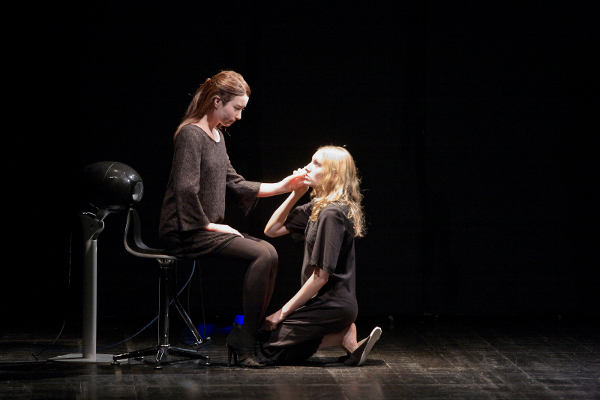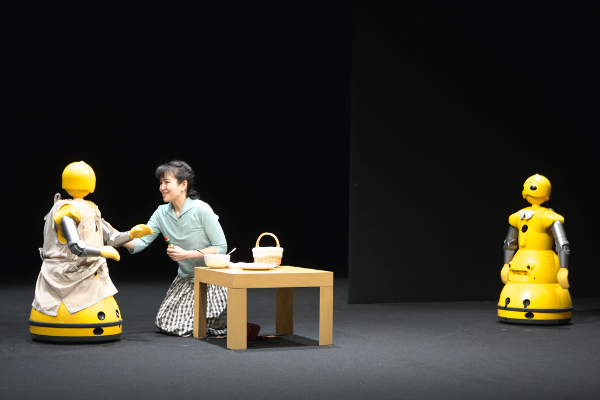
Philadelphia Live Arts Festival presents “Robot-Human Theater”
Philadelphia Live Arts Festival and Philly Fringe proves that its promise to provide quality, year-round programming to the region is in full swing. This Knight Arts grantee just brought the first ever “Robot-Human Theater” to Old City’s Christ Church Neighborhood House. Produced by Seinendan Theater Company and Osaka University Robot Theater Project, this innovative and ambitious performance confronts robots with live human actors. The result is an intriguing vision into what it means to be human, what it means to be a robot and what exactly makes an actor. Both performances are directed by Ozira Hirata, who joined the theatergoers afterward for a post-show panel discussion.
As the audience filters into their seats for the first act, entitled “Sayonara,” two women sit on stage in the dark, motionless, waiting for the play to begin. At the outset of the action, both remain seated and begin to have a discussion. They bounce intellectual and emotional concerns off of one another, eventually blossoming into a full-blown conversation about languages and poetry. Each recites poems in turn, in various tongues, and their dialogue gives way to a somewhat unnerving fact: the leftmost woman is no woman at all – she is an android. Purchased for the girl by her father, it is revealed that the she is sick and near death. Eventually, the exchange progresses to confront the weight of loneliness and what it means to be happy. All the while, we compare the two actors, and wonder what exactly the mechanical one may be feeling. Do androids think? Do they feel? Is this highly realistic figure perhaps a woman acting like a machine?
The second part of the first act smites any doubts as to the latter question when a repairman arrives to service the apparently malfunctioning android. He converses on a cell phone in Japanese, posing questions to his home office while also fielding inquiries from the robot. While the android seems fairly functional, it begins to repeat a few phrases and it is determined there is a problem. The serviceman asks if the android would prefer to remain ‘on’ during transportation, and the reply is affirmative. He hoists the female figure up onto his shoulder, the limbs stiff and inhuman, and exits the stage. Until the end of the scene, viewers seem to harbor at least a little doubt that this actor is a machine, but as the first act finishes, this definitive motion turns even skeptics into believers.
Robot-Human Theater: I, Worker. Photo by Tsukasa Aoki
After the intermission, a couple takes the stage with a pair of robots for “I, Worker.” This time there is no question as to the robots’ nature – they are human in their general structure with arms and heads, but they are made from colored plastic, have wheels instead of legs, and large, curious eyes. By any definition, they are quite cute, and elicit a fond reaction from the audience, as opposed to the confusion and concern brought on by the android. One dons an apron and serves as the pair’s cook. The other helps around the house. Eventually it becomes clear that the man in this scene is unemployed, creating tension between him and his wife, and raising questions as to the robot workers. Does technology actually infringe on human workers by displacing jobs? While the couple’s life seems luxurious with robotic butlers, one cannot help but wonder what automatons may have ultimately led to the man’s joblessness.
Near the end, the wife leaves to go watch the sunset without her husband. When the man asks one of the robots if the sunset is beautiful, it replies that, by human standards, it most probably is. The man chuckles at the question he asked the machine, and he leaves the two robots alone together. Their final exchange concludes in an open-ended fashion, leading the audience to believe that the robot indeed found the sunset appealing, at least in some way. By the end of an act which led us to believe these facsimiles were merely workers, we are suddenly struck by the idea that they may be sharper than we first imagined.
If anyone was concerned about a Terminator-style takeover or technological singularity, don’t fret. These robots require sensors, pre-programming, and remote control for proper functioning. While they appear to be acting completely on their own, the Oz-like hands of the director guide them the entire way. Even if they are not fully autonomous, these strange Japanese creations, along with their human counterparts, provide a deep and complicated intrigue into their existence and our own.
The Philadelphia Live Arts Festival and Philly Fringe: [email protected]; www.livearts-fringe.org.
Recent Content
-
Artsarticle ·
-
Artsarticle ·
-
Artsarticle ·

